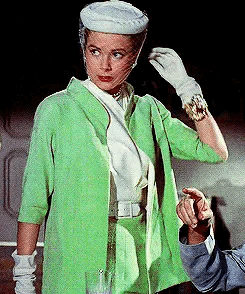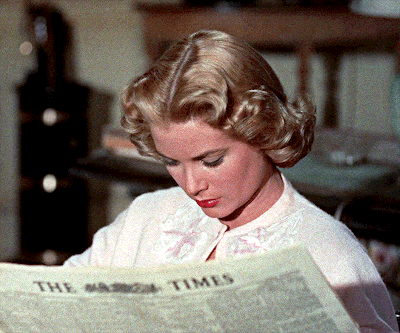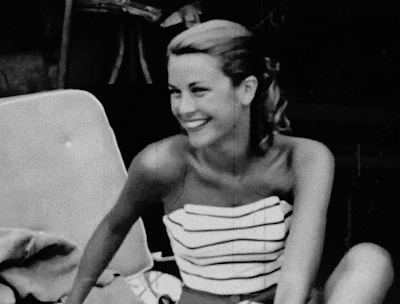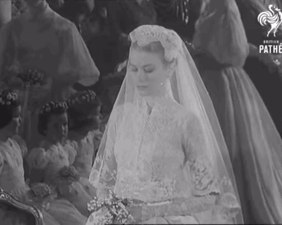The Myth of Grace Kelly, Actor
Icy cool, Hitchcockian blonde, regal and graceful… today we remember her more for being a clotheshorse and the Princess of Monaco, but all Grace Kelly ever wanted was to be a serious actor.
She had the drive and the discipline and was always vocal in
interviews about how hard she worked to be Grace Kelly. She might have
grown up in a wealthy Philadelphia family, but make no mistakes: Grace did it
her way.
In a January 1955 interview with Photoplay, Grace said:
“I
always liked make-believe games. But what helped me succeed, I think, is that
different opportunities came along at a lucky time. They didn’t come before I
was ready, if you know what I mean. There’s all this talk about making your
opportunity but what’s the good of breaking down a door before you’re
prepared?”
The aptly titled ‘The Lady is a Go-Getter’ is a revelation
from Grace in her own words. She tells Martin Cohen all about her rise from
acting student to model, live television performer to Hollywood starlet.
And for anyone else, it might’ve gone to their head. But not
Grace. For Grace, it was all about the work and doing serious work, parts she
believed in. By 1955, she was the crème de la crème of Hollywood. I’m trying to
think of an actor that had a better year than Grace Kelly in 1954.
In that year alone, she starred in Dial M for Murder, Rear Window, The Country Girl, Green Fire, and The Bridges at Toko-Ri. She was already an Oscar nominee for Mogambo. Her only film of 1955 would be To Catch a Thief, but it, too, would go on to become a classic.
But despite the success, Grace was pragmatic about her output:
“I’ve had a couple of parts I didn’t like,” she revealed. “I was
bored and miserable. I couldn’t work up any sympathy for the characters. If I
had to do much of that I’d stop cold. The day I find acting is no longer fun
and exciting, I’ll quit.”
Grace never wanted to play the Hollywood game; she was there to work, to do work she stood behind, and to make important art. She gladly went on suspensions when she disagreed with projects MGM wanted to stick her in (even though she sometimes lost the battle. See: Green Fire.) and was willing to work with other studios to make the movies she wanted (see: The Country Girl).
Grace was on the cusp of winning an Oscar for The Country
Girl at the time of this interview, and yes, I recognize that I’m about the
only one who thinks it was deserved over Judy Garland’s career turn in A
Star is Born, spare me the comments!
With the sudden fame, Grace recognized that all the attention
was just noise distracting from the decades of work it took to get her to the moment.
“Everything’s happened—all the publicity—in the
past year,” Grace said, “So I get the sweepstakes’ winner
treatment. Frank Sinatra was talking about this and he said, ‘I remember they
called me an overnight sensation. It made me sore. It wasn’t overnight. It was
ten years of hard work.’”
For Grace, it was discipline: “Discipline is getting up at
six a.m. in Hollywood when you’d rather be in New York waking at eleven.
Discipline, too, is learning something new and strange or refusing a second
piece of cinnamon toast. Discipline is not putting things off until tomorrow.”
She added: “When you’re working on a film, you put everything
into it. For months at a time. You lose yourself in the work. Then, when it’s
over, you try to catch up with your other self, the part that’s not the
actress. You try to catch up with the part that’s a private citizen, a daughter
and sister, a friend.”
One of her best friends, Rita Gam, ‘wrote’ an article for the
April 1955 Photoplay entitled ‘That Girl Kelly and Me’ all about their
friendship.
Rita said about Grace, “Grace is lucky, it’s true, because
she comes from a family of background and money and protection so that she
comes equipped with strength. But you can misuse this, you know, and she
hasn’t.”
Grace was a poor student—by her parents’ exacting standards—and
didn’t earn the grades to continue on at university. Instead, she knew she wanted
to be an actor. Her parents reluctantly let her go to New York, study at the Academy
of Dramatic Arts, and paid her way. But she didn’t want to be stuck under their
thumbs anymore than she needed to be, so she began modelling and working on
live television productions to supplement her income.
Soon, Hollywood came knocking. With a bit part in 1951’s Fourteen
Hours, she parlayed it into a role in High Noon opposite Gary
Cooper. From there, Mogambo in 1953, which led to her first Oscar
nomination in the Best Supporting Actress category (she lost to Donna Reed);
and then the rest is history.
Rita said that Grace represented the best of what mid-century
Hollywood offered: authentic and dedicated. “What we want is to get away
from the nonsense, away from the lush self-indulgence and extravagance you read
about in the earlier days of Hollywood that gave us no life at all, to
something that does.”
And Grace’s approach to fame was to treat it as an extension
of her life, Rita said, not the pinnacle. “Grace works very hard at her job,
studies quite a lot, is a very careful and conscientious actress. Real
dedicated. Yet she wants to live her life on several levels, wants to have and
intends to have as full and rounded a life as possible.”
Rita said about Grace that just because she “doesn’t fit
into any cliché, doesn’t carry a pet monkey on her shoulder, doesn’t go for
exhibitionism of any sort or kind, people say she’s cold, shy. She isn’t cold.
Everything Grace does stems from a very feeling person. But deep feeling and
real, not just for show.”
Grace said in the January issue, “I’ve never been depressed
by my work. I love it. If it became a chore, I’d give it up.”
Exactly one year later, Grace’s engagement to Prince Rainier
III of Monaco was announced. She’d finish the final movies in the pipeline, The
Swan and High Society, and swan off to Monaco for a different career
as royal consort.
And even though she gave up her career to do it, it was on her own terms yet again.






Comments
Post a Comment